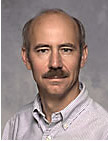(See Projects story on the Safety
Vehicle.)
Where are you from originally?
A little town outside a little town in the Upper Peninsula
of Michigan. It's a place on the map called Fiber. It's
only on the map because there's plenty of room on the page
at that spot.
How big is Fiber?
When I was growing up, it had a gas station, post office, and store - of course, they were all in one building. The whole area may be 100 people. Everything out our back door was the Hiawatha National Forest. I went to high school in neighboring Rudyard.
Where did you go to college?
Michigan Tech in Houghton. I started as a geology major but eventually switched to engineering. I raced motorcycles and snowmobiles when I was younger, so engineering was a natural choice.
What did you do after graduation?
I received my MS in Mechanical Engineering, then went to work at GM's Lansing Automotive Division. Initially I was a crashworthiness engineer, then a design engineer. A lot of crashworthiness analysis involves working on design, and eventually I decided that's what I wanted to do.
How were you able to earn your PhD while also working?
Before I went to work for GM, I had already applied and been accepted to earn my doctorate. But I chose to work for a while and make some money. Then I heard about the GM PhD Fellowship Program. I applied for it and Tom Davis, the former head of Lansing Automotive Division, approved me for it.
How long did you work before you went back to school?
About seven years.
How does the GM PhD Fellowship Program work?
I was an employee and a student at the same time. I went to school for one year, took classes, and finished my qualifying exams. Then I went back to the division to choose a project that applied to work but was still theoretical enough to satisfy the PhD requirements. It was difficult to come up with a project that made both parties happy.
What happened next?
I had previously worked for Mike Lawless on a car program. He told me the best thing I could do with a PhD was to work for R&D. He set up an interview for me with J.T. Wang at R&D and it all worked out. I've been working in research since 1994. I feel very lucky that GM sponsored me for my PhD - otherwise, I never would have gone back to school.
What were your early assignments at R&D?
I'd worked in topology optimization at school and essentially made it more user-friendly. Topology optimization is a fancy term for putting holes in things to make them lighter. It's hard to do. If you want to change the shape of something, you can just vary the dimensions. But if you want to put a hole in something, you have to decide where to put it, how big it's going to be - there are all kinds of decisions. It uses finite element analysis, and every one of those elements is a variable that could either turn on or off or even be in-between. You end up with a structure with holes in it that make it the optimal design.
What kind of structures are you putting holes in?
Structural parts, like the rear rail. The last example I did with Opel was the front bumper bracket.
You've also worked in crashworthiness analysis?
Yes, both with topology optimization and with the safety vehicle project. At first, the safety vehicle project didn't seem like that much fun, because I didn't realize how much research would be needed. Later I saw just how much we could do.
What is your proudest accomplishment at R&D?
The topology optimization work, because it was very theoretical … and I had to relearn quite a bit of math to do it! It was hard work and that made it more rewarding.
What excites you about your research?
The rapid advances in technology, not just in my area, but everywhere. Everywhere you look, you see something working faster and better. It's exciting. It's hard to keep up.
How do you keep up with changes?
I try to read a paper or two in the morning before work really gets going. I feel I'm pretty lucky to be able to do that. We don't have as many meetings at R&D as we did in the division, so I enjoy a lot more freedom.
What are your other research interests?
Bicycle design - although that has nothing to do with GM. But the design process is something that I've always been interested in. There are codes in CAD that allow you to quickly change the design and mesh and then do an analysis. Years ago, we might design one part, build that part, and test it. Today, analysis is automated, so we can do 10 designs, compare the results, and use an algorithm to choose the best option.
Design itself is very interesting, because there is no single answer. As they say, "At some point you have to shoot the engineers and build." Design engineers will work on something forever if you let them, so you're really never done designing. That's what I'm working on now - improving the design process.
What do you do when you're not working?
Biking, running, or swimming. The coordinating hobby is triathlon. My wife says I do the triathlons as an excuse to exercise, but she bikes and swims quite a bit too.
Your favorite vacation spot is Banff National Park?
Yes. My wife and I really enjoy the Lake O'Hara area. You take a bus and stay at the lodge or in cabins in a secluded valley. Then you eat a lot and hike a lot. We just love it.




